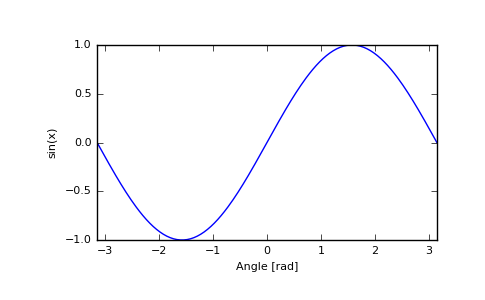numpy.sin¶
-
numpy.sin(x, /, out=None, *, where=True, casting='same_kind', order='K', dtype=None, subok=True[, signature, extobj]) = <ufunc 'sin'>¶ Trigonometric sine, element-wise.
Parameters: x : array_like
Angle, in radians (
 rad equals 360 degrees).
rad equals 360 degrees).out : ndarray, None, or tuple of ndarray and None, optional
A location into which the result is stored. If provided, it must have a shape that the inputs broadcast to. If not provided or None, a freshly-allocated array is returned. A tuple (possible only as a keyword argument) must have length equal to the number of outputs.
where : array_like, optional
Values of True indicate to calculate the ufunc at that position, values of False indicate to leave the value in the output alone.
**kwargs
For other keyword-only arguments, see the ufunc docs.
Returns: y : array_like
The sine of each element of x.
Notes
The sine is one of the fundamental functions of trigonometry (the mathematical study of triangles). Consider a circle of radius 1 centered on the origin. A ray comes in from the
 axis, makes
an angle at the origin (measured counter-clockwise from that axis), and
departs from the origin. The
axis, makes
an angle at the origin (measured counter-clockwise from that axis), and
departs from the origin. The  coordinate of the outgoing
ray’s intersection with the unit circle is the sine of that angle. It
ranges from -1 for
coordinate of the outgoing
ray’s intersection with the unit circle is the sine of that angle. It
ranges from -1 for  to +1 for
to +1 for  The
function has zeroes where the angle is a multiple of
The
function has zeroes where the angle is a multiple of  .
Sines of angles between
.
Sines of angles between  and
and  are negative.
The numerous properties of the sine and related functions are included
in any standard trigonometry text.
are negative.
The numerous properties of the sine and related functions are included
in any standard trigonometry text.Examples
Print sine of one angle:
>>> np.sin(np.pi/2.) 1.0
Print sines of an array of angles given in degrees:
>>> np.sin(np.array((0., 30., 45., 60., 90.)) * np.pi / 180. ) array([ 0. , 0.5 , 0.70710678, 0.8660254 , 1. ])
Plot the sine function:
>>> import matplotlib.pylab as plt >>> x = np.linspace(-np.pi, np.pi, 201) >>> plt.plot(x, np.sin(x)) >>> plt.xlabel('Angle [rad]') >>> plt.ylabel('sin(x)') >>> plt.axis('tight') >>> plt.show()
(Source code, png, pdf)
